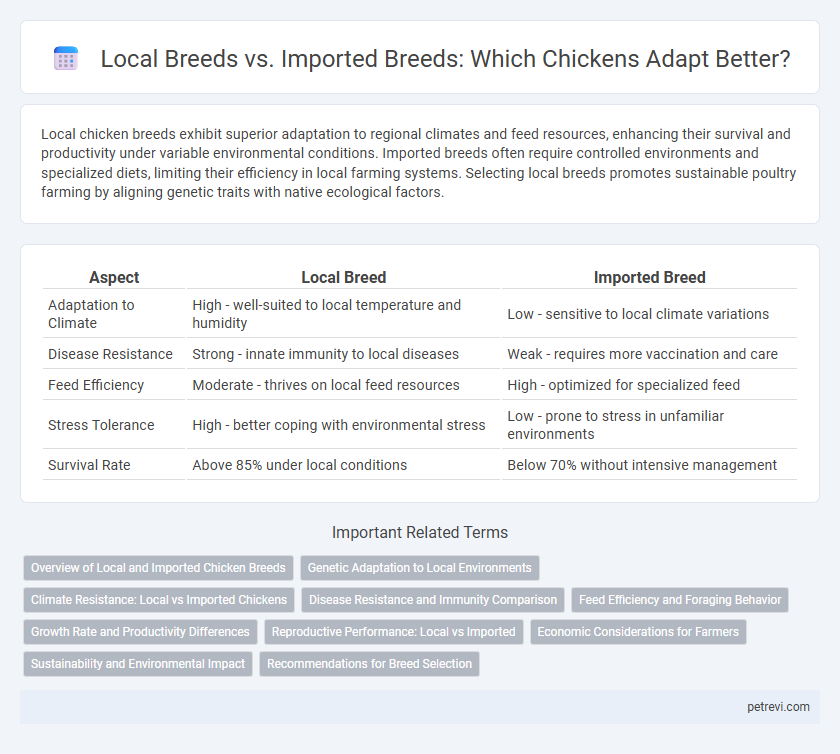Local chicken breeds exhibit superior adaptation to regional climates and feed resources, enhancing their survival and productivity under variable environmental conditions. Imported breeds often require controlled environments and specialized diets, limiting their efficiency in local farming systems. Selecting local breeds promotes sustainable poultry farming by aligning genetic traits with native ecological factors.
Table of Comparison
| Aspect | Local Breed | Imported Breed |
|---|---|---|
| Adaptation to Climate | High - well-suited to local temperature and humidity | Low - sensitive to local climate variations |
| Disease Resistance | Strong - innate immunity to local diseases | Weak - requires more vaccination and care |
| Feed Efficiency | Moderate - thrives on local feed resources | High - optimized for specialized feed |
| Stress Tolerance | High - better coping with environmental stress | Low - prone to stress in unfamiliar environments |
| Survival Rate | Above 85% under local conditions | Below 70% without intensive management |
Overview of Local and Imported Chicken Breeds
Local chicken breeds exhibit superior adaptation to diverse environmental conditions and local diseases, ensuring higher survival rates and resilience in traditional farming systems. Imported chicken breeds, often selected for high productivity traits like rapid growth and increased egg production, require controlled environments to perform optimally and are more susceptible to local pathogens. Understanding the balance between local breed hardiness and imported breed efficiency is essential for sustainable poultry farming in varying climatic regions.
Genetic Adaptation to Local Environments
Local chicken breeds exhibit superior genetic adaptation to regional climates, diseases, and feed availability, resulting in enhanced survival rates and productivity under specific environmental stresses. Imported breeds often prioritize growth and yield traits but may suffer from reduced resilience and higher susceptibility to local pathogens and temperature variations. Strategic crossbreeding programs leveraging local breeds' genetic traits can optimize adaptation while improving overall chicken performance.
Climate Resistance: Local vs Imported Chickens
Local chicken breeds exhibit superior climate resistance due to their genetic adaptation to regional temperature fluctuations, humidity, and disease prevalence. Imported breeds often struggle in unfamiliar climates, leading to higher mortality rates and reduced productivity. Selecting local breeds enhances sustainability and resilience in poultry farming under challenging environmental conditions.
Disease Resistance and Immunity Comparison
Local chicken breeds exhibit stronger disease resistance and adaptive immunity due to long-term exposure to regional pathogens and environmental stressors. Imported breeds often show higher productivity but may lack resilience against local diseases, increasing vulnerability to infections and requiring more intensive health management. Optimizing poultry farming involves balancing the robust immunity of local breeds with the growth advantages of imported varieties through selective breeding and vaccination strategies.
Feed Efficiency and Foraging Behavior
Local chicken breeds exhibit superior adaptation to harsh environmental conditions through enhanced foraging behavior, enabling them to efficiently source natural feed and reduce dependency on commercial feed. Imported breeds, while often showing higher growth rates, typically have lower feed efficiency in free-range systems due to limited natural foraging skills and higher metabolic demands. Optimizing chicken production requires matching breed selection to local environmental conditions, maximizing feed conversion ratios by leveraging local breeds' innate foraging adaptability.
Growth Rate and Productivity Differences
Local chicken breeds exhibit greater adaptability to harsh environmental conditions, resulting in higher survival rates and sustained productivity in native climates. Imported breeds often demonstrate faster growth rates and increased meat or egg production under controlled conditions but may struggle with local diseases and climate variability. Optimal poultry production balances the robust resilience of local breeds with the enhanced productivity traits of imported breeds through crossbreeding strategies.
Reproductive Performance: Local vs Imported
Local chicken breeds typically exhibit superior reproductive performance in their native environments due to better adaptation to local climate, disease resistance, and feed availability, resulting in higher fertility rates and hatchability. Imported breeds often show enhanced growth rates and egg production under controlled conditions but may experience reduced fertility and lower hatchability when exposed to local stressors. Evaluating reproductive metrics such as clutch size, egg fertility, and hatchability percentage is essential for optimizing breed selection and improving poultry production sustainability in specific regions.
Economic Considerations for Farmers
Local chicken breeds often exhibit superior adaptation to regional climates and feed resources, reducing overall input costs for farmers through lower veterinary expenses and enhanced survivability. Imported breeds may offer higher growth rates and meat or egg production but require more intensive management, specialized feeds, and health interventions, increasing operational expenses. Economic viability hinges on balancing productivity benefits against the elevated costs associated with maintaining imported breeds under local environmental conditions.
Sustainability and Environmental Impact
Local chicken breeds exhibit higher adaptability to regional climates and forage availability, enhancing sustainability through reduced reliance on external feed and veterinary inputs. Imported breeds often require controlled environments and specialized diets, increasing energy consumption and environmental footprint. Utilizing indigenous breeds supports biodiversity and fosters environmentally resilient poultry farming systems.
Recommendations for Breed Selection
Local chicken breeds exhibit superior adaptation to harsh climatic conditions and endemic diseases due to their genetic resilience, making them ideal for sustainable farming in tropical and subtropical regions. Imported breeds, while often faster-growing and higher-yielding, require intensive management and controlled environments to perform optimally, which may increase production costs and vulnerability to local pathogens. Recommendations for breed selection emphasize prioritizing local breeds for backyard or low-input systems and considering imported breeds only in well-resourced operations with the capacity to mitigate environmental stressors and disease challenges.
Local breed vs Imported breed for Chicken Adaptation Infographic

 petrevi.com
petrevi.com